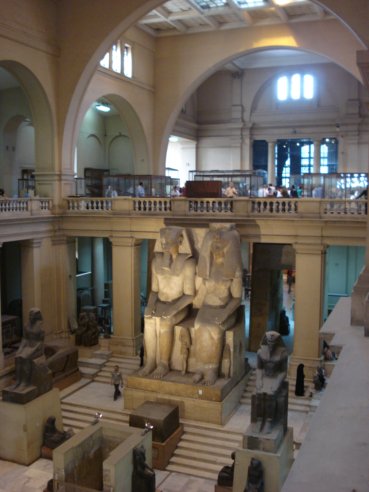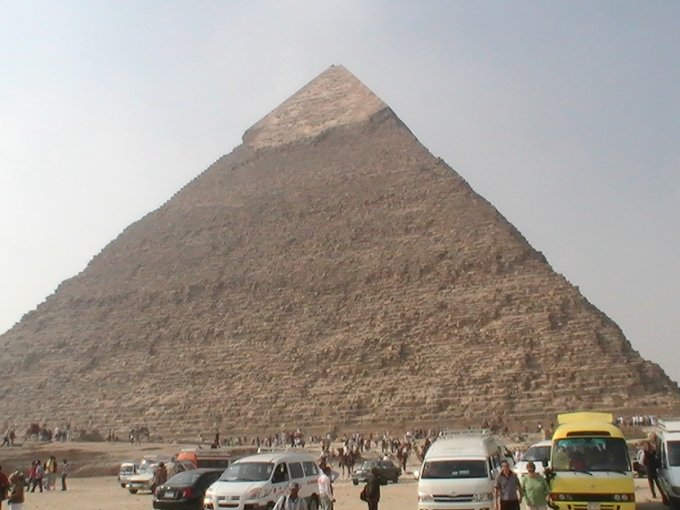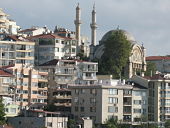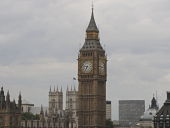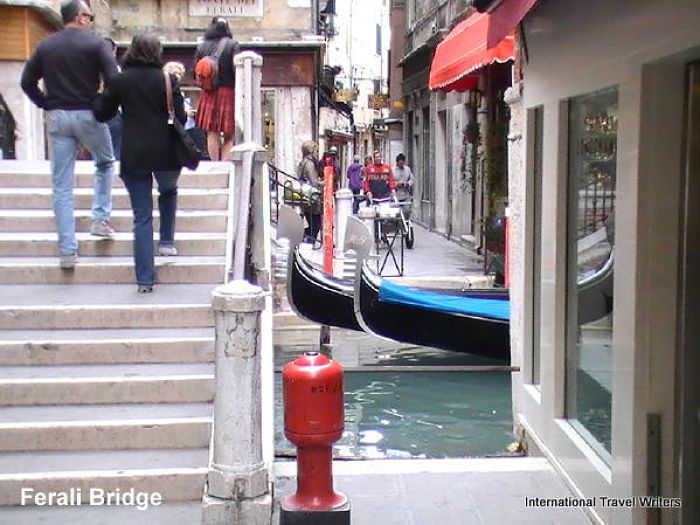Egypt's first capital of Memphis, Temple of Ptah and Ramesses II
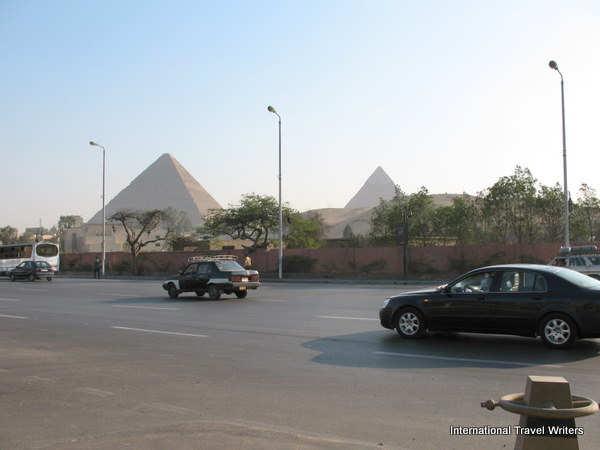
More of Egypt still awaited us so after breakfast and checking out of the hotel we got on the bus and headed south on the blacktopped, modern road to the country's first capital of Memphis. The Temple of Ptah, the fallen colossal statue of Ramesses II and the Alabaster Sphinx of King Amenophis II were ahead.
Afterward we would drive to the oldest ancient cemetery of Saqqara ( 19 miles from Cairo) and see the Step Pyramid of King Djoser as well as continue our trek to one of the nearby Mastabas (tombs) to visit the renowned one, Ti.
Following would be the Giza Plateau, to gaze in stunned reverence at the only remaining Wonder of the Ancient World...the astonishing and beguiling Pyramids of Giza. Because these are in full view from the local highway, an aura, a weird sense of the past blending into your current day permeates your inner compass. You can sit and marvel at the spectacle from a restaurant or a hotel window...viewing the pyramids through the prism of time as easily as being at home gazing at Seattle's Mt. Rainier.

First we drove to the Open air Museum at Memphis. Memphis was founded in the First Dynasty (3100 B.C.) by King Narmar. The location was symbolic because it was located at the junction of the Delta and the Nile Valley, of Upper and Lower Egypt. For much of the time it was the capital of the “Two Lands” but Memphis became the first capital city founded after the unification of Upper and Lower Egypt.
Even when Thebes grew to be the royal and religious capital during the New Kingdom, Memphis retained its status as administrative capital. Memphis lost its importance during the Ptolemaic Period, when Alexandria was the preferred royal residence.
The local God of Memphis was Ptah, the God of creation and workmen. There aren’t many remains from ancient Memphis, except some monuments from the New Kingdom and later periods.
Today it is the location of a modern village called Mit Rahina. The colossus King Ramesses II is housed there. This enormous, mind boggling statue is carved in limestone and even without the remainder of his legs and feet he measures approx. 34 feet long. We were told the building holding him was built around the statue as it was just too massive to move. There are other remains of granite statues and granite coffins along with tablets from later periods.
The founder
of the 19th Dynasty, Ramesses I, reigned 1293-1291 B.C. Reigning only
two years, he was succeeded by his son, Seti I, who reigned 1291-1279
B.C. One of his sons, Ramesses II succeeded him and reigned for nearly
67 years. He was responsible for the majority of the construction at
Luxor and Karnak. He build the Ramesseum (his funerary temple at
Thebes), the rock-cut temples at Abu Simbel, and sanctuaries at Abydos
and Memphis. How appropriate, that this daunting collossus was befitting the stature of not just the man, but was representative of his gigantic achievements.


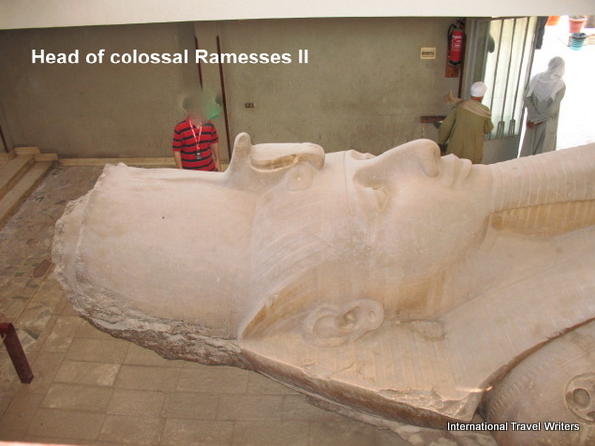
Also at this complex is the giant Alabaster Sphinx of King Amenophis II, weighing more than 80 tons, which once stood outside the massive temple of the God Ptah.

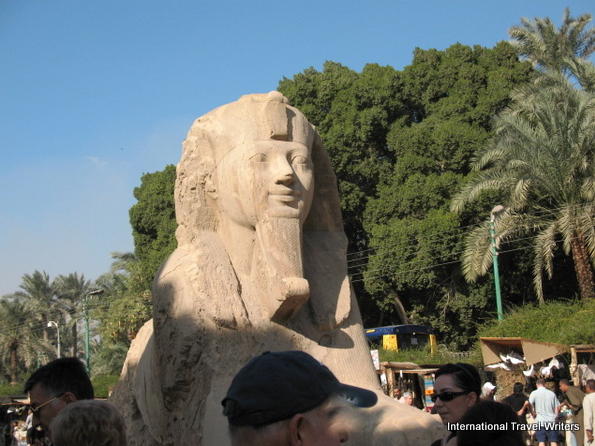
Vendors have stalls lined along the perimeter selling souvenirs and mementos. The selection is pretty much the same as the items available in small shops in Cairo such as marble replicas of the Alabaster Sphinx and copper pyramids depicting the Pyramids of Giza.
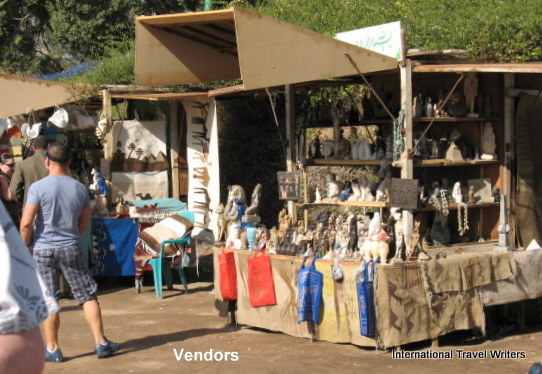
The ancient building of Pyramids was in some part, a religious undertaking. Ancient Egyptians believed that when the pharaoh died, he became Osiris, king of the dead. The new pharaoh become Horus, god of the heavens and protector of the sun god. This cycle was symbolized by the rising and setting of the sun. Part of a dead pharaoh's spirit, called his ka, was believed to remain with his body.
It was also believed that if the corpse wasn't properly cared for, the former pharaoh wouldn't be able to carry out his new duties as king of the dead. If this happened the cycle would be broken and disaster would befall Egypt. To prevent this kind of catastrophe, each dead pharaoh was mummified, which preserved his body.
Everything the king would need in his afterlife was provided
in his grave...vessels made of clay, stone, gold, furniture, food, even
doll-like replicas of servants, known as ushabti. Mummified
bodies were typically housed in a traditional, flat-roofed mastaba
(tomb). However, believing that grave robbers were looting the mustabas
making it less desirable in the after-life, new ways of protecting the
remains were being considered. Imhotep, vizier to Pharaoh Djoser, was
given the task of creating a new type of tomb.
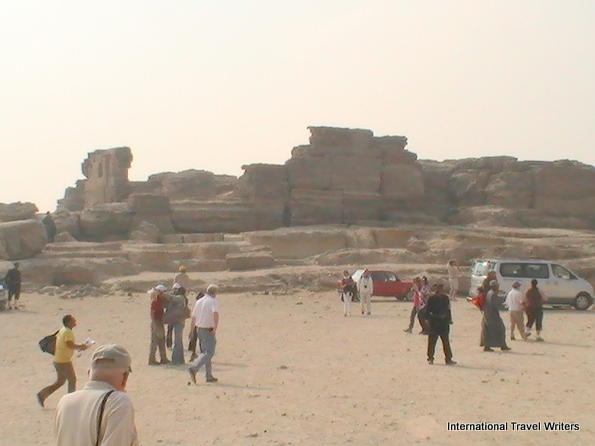
Southern Saqqara is approx. 12 miles from Memphis so that was our next stop. Sixteen Egyptian kings built pyramids at Saqqara, which are now in various states of restoration or dilapidation. High ranking officials added private monuments to this necropolis during the entire pharaonic period and it remained a prized complex for non-royal burials and cult ceremonies well into Ptolemaic and Roman times.
North of the area known as Saqqara lies Abusir; south lies Dahshur. The area of Egypt running from Giza to Dahshur has been used as a necropolis by the inhabitants of Memphis at different times, and it was designated as a World Heritage Site by UNESCO in 1979.
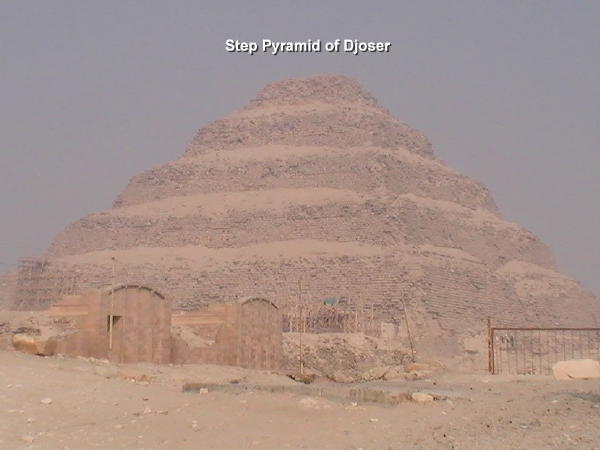
Saqqara was the vast ancient burial ground for Memphis and the site is dominated by the Step Pyramid of Pharaoh Djoser (King Zoser) which dates back to the third dynasty, built approx. 2700 B.C. It is one of the oldest stone structures in the world and is entirely built of limestone.
Northern Saqqara is dominated by the Pyramid of King Teti, and mastaba (Arabic for “bench”) tombs of the old kingdom. Imhotep, Djoser’s vizier, in his attempt to create a new style tomb kept adding new levels to the tomb during Djoser's 19 year reign...creating steps whereby Ba, the Spirit on earth could climb to join Ka, the body in heaven.
Hence the Step Pyramid has six steps. Pyramids, albiet larger and grander, would be in fashion until Amenhotep I, who reigned from 1551 -1524 B.C. decided to hide his tomb. His is the first in the Valley of the Kings.

In the southeastern part of the wall you will find the entrance to the Saqqara necropolis, Djoser complex. The new Imhotep Museum was opened in 2006. The entrance leads to a colonnade that has a hypostyle hall with 40 columns making it the oldest surviving hall of this type in the world.
In between the columns are a large number of little rooms that once contained statues representing Pharaoh Djoser as ruler of Upper and Lower Egypt. The long hall leads to an open courtyard which was used by the king while performing the rituals of the jubilee feast…also called the Heb-Sed festival. This was a ritual perfomed by Kings of Ancient Egypt to ensure that they were able to rule the country for another 30 years.

To the right of the open courtyard, Imhotep built a temple called the Heb-Sed Temple, so that the king would be able to practice the ritual in the after-life. Temple Ti lies close to the entrance to the Heb-Sed temple. The temple is a rectangular building with three carved fluted columns, joined by supporting walls, forming niches which probably housed statues of kings. Beyond the entrance hall are three inner courts and a collection of small chambers.
It is thought that the temple was meant to represent the pavilion where the Pharaoh prepared for his Heb-Sed festival. Behind the Temple, further north, are two buildings behind each other and they are called the northern and southern houses. The King would host dignitaries who came to attend the King’s ritual in the Temple.

On the south side of the step Pyramid complex is the ruined Pyramid of King Unas which dates back to the end of the 5th Dynasty.

In the south-western corner there is a dummy building known as the Token Palace. It probably represents the temporary pavilion set up for the pharaoh to rest during the rituals. The façade had imitated a reed matting and was topped by cobras with their hoods flared, poised to strike.
This was a symbol of the great goddess of the Delta city of Buto, patroness and protector of the pharaoh. This same image is part of the royal headgear, where she sits on his forehead, poised to strike out at his enemies.
Secondary tombs can be found at some Old Kingdom pyramids and in some cases they are believed to belong to the pharaoh’s principal wives. It was at this wall that a policeman beckoned to my husband and took him up a crude stairway that led to a secret viewpoint...of course he wanted a tip for this. My husband later informed me that it wasn't so secret and that he would have found the crumbled stairs on his own...without paying a tip.

The Djoser Pyramid Complex in Egypt is a fascinating step into the past that I highly recommend to others. Although it doesn't rank as a Wonder of the Ancient World like the Giza Pyramids do, it's still an area of Egypt that fires up the imagination when you see the partially exposed limestone blocks that perhaps house other great artifacts not yet discovered. For us, we were heading to the Giza Pyramids, so we prepared to board the bus.
Having trouble finding what you need? International Travel Writers Index and Map
OR
Do you have a travel experience or story to share? Share your travels here!
Related Articles.....
Return from Egypt-3 to International Travel Writers Homepage
By Carolynne Woods, © Copyright 2010-2020. International Travel Writers.com All rights reserved images and text

